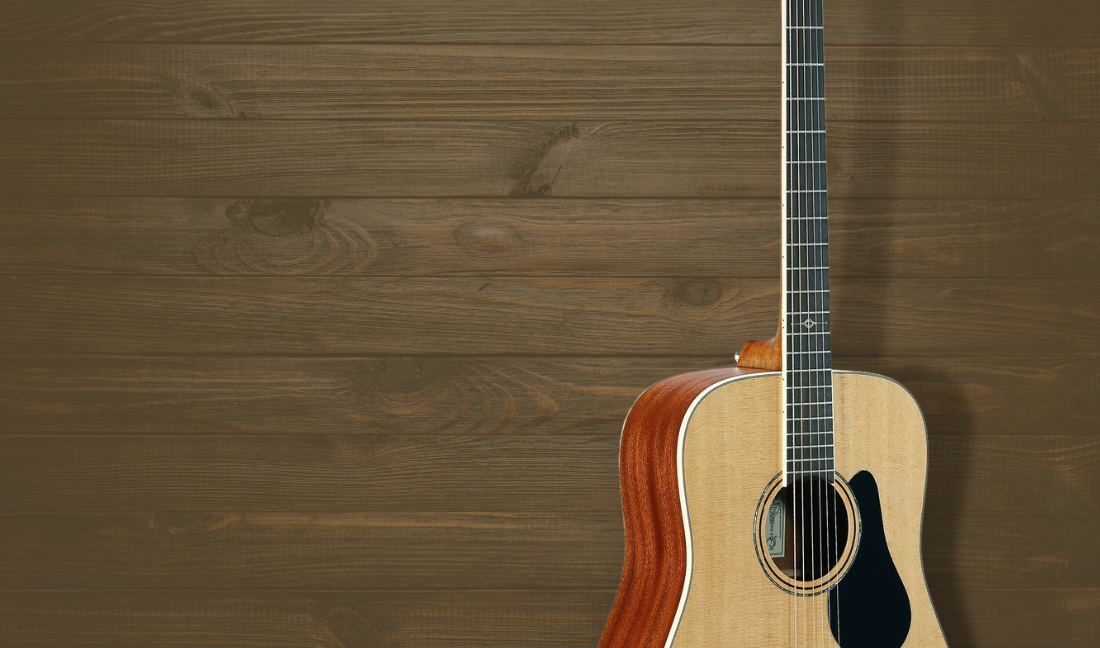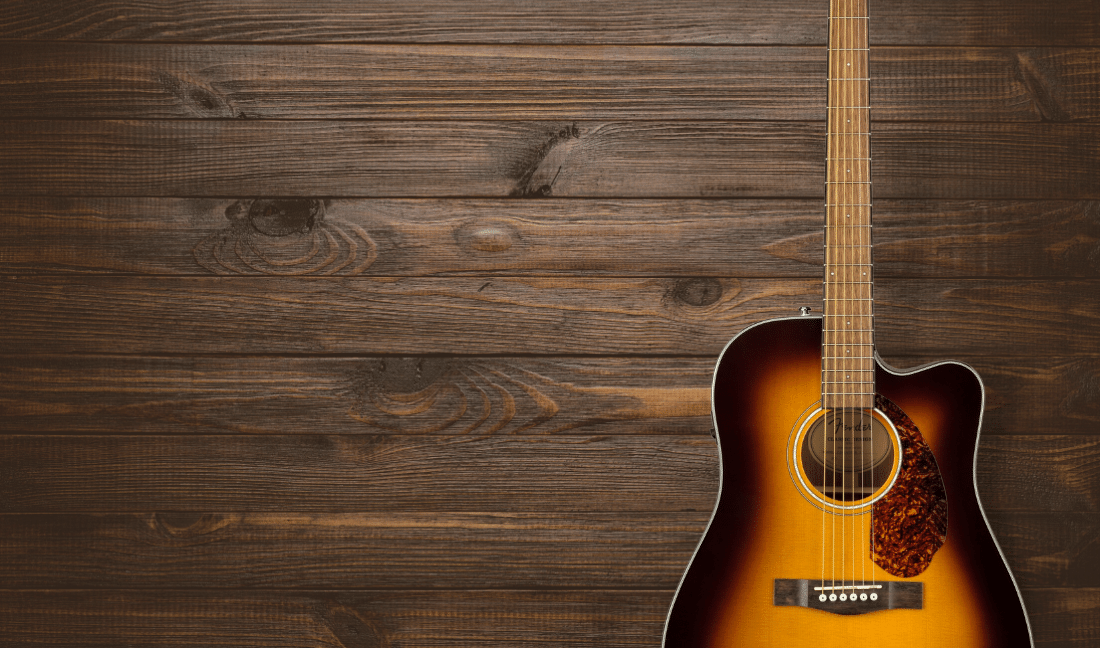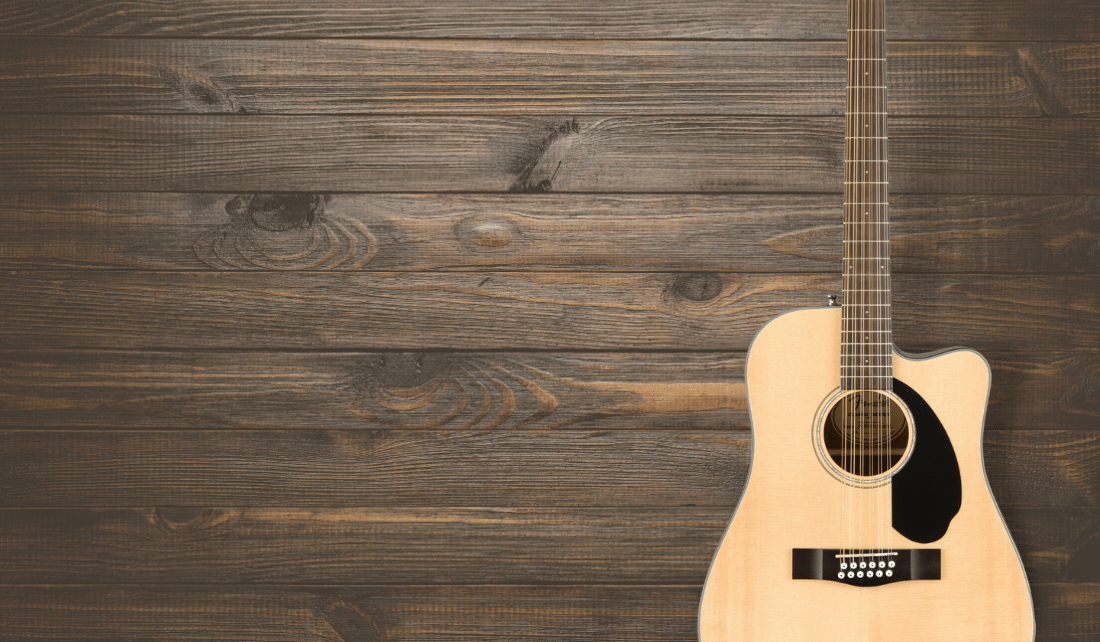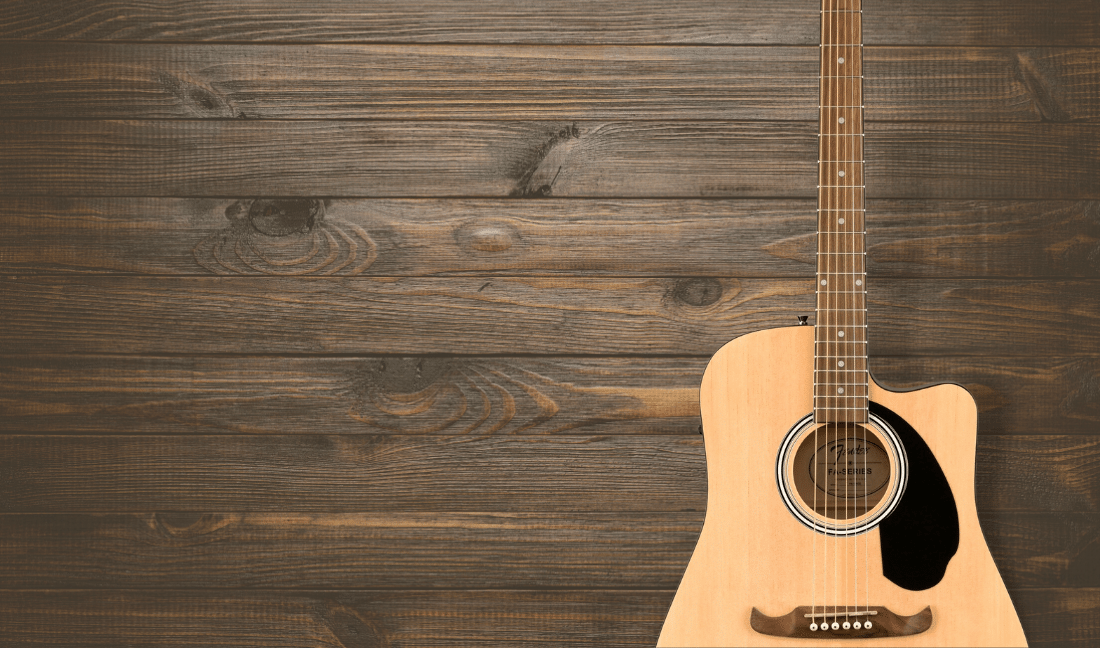The Alvarez AD60 is a fantastic acoustic guitar that has long been a favorite of guitarists of all levels.
It features a non-cutaway body with gloss finish, a top made of solid a+ sitka spruce, back and sides made of african mahogany, and a 25.5″ scale length.
You can purchase this guitar in many different stores, some of them include:
We may earn commissions from these links at no additional cost to you
#REF!
Some guitar features have a bigger impact on the sound and playability than others; we’ll help you identify which ones those are.
Table of Contents
Summary
#REF!
Also, the score and rating we give is just our own personal opinion and experience so it’s subjective.
Hardware
The many metal and plastic elements that make up a guitar are referred to as the hardware.
These include but are not limited to:
- Tuning machines
- Pickguard
- Bridge
- Strings
- Strap buttons
- Pickups
- Tailpiece
- Control knobs
The term “hardware” on an acoustic guitar refers to any of the physical parts that make up the guitar itself.
When buying a guitar based on its hardware, be sure it’s of decent quality and will last a long time.
For example, lower-quality guitars often have plastic saddles on the bridge, which can negatively affect the sound and intonation of the instrument, and also make it more difficult to keep in tune.
You should also ensure that the metal parts are not susceptible to rusting or tarnishing and look to be strong and durable, without being easily dented.
A decent-sounding and playable guitar requires excellent hardware, and there are a few things that a manufacturer can do to make it perfect for us guitarists.
Let’s take a look at it more closely!
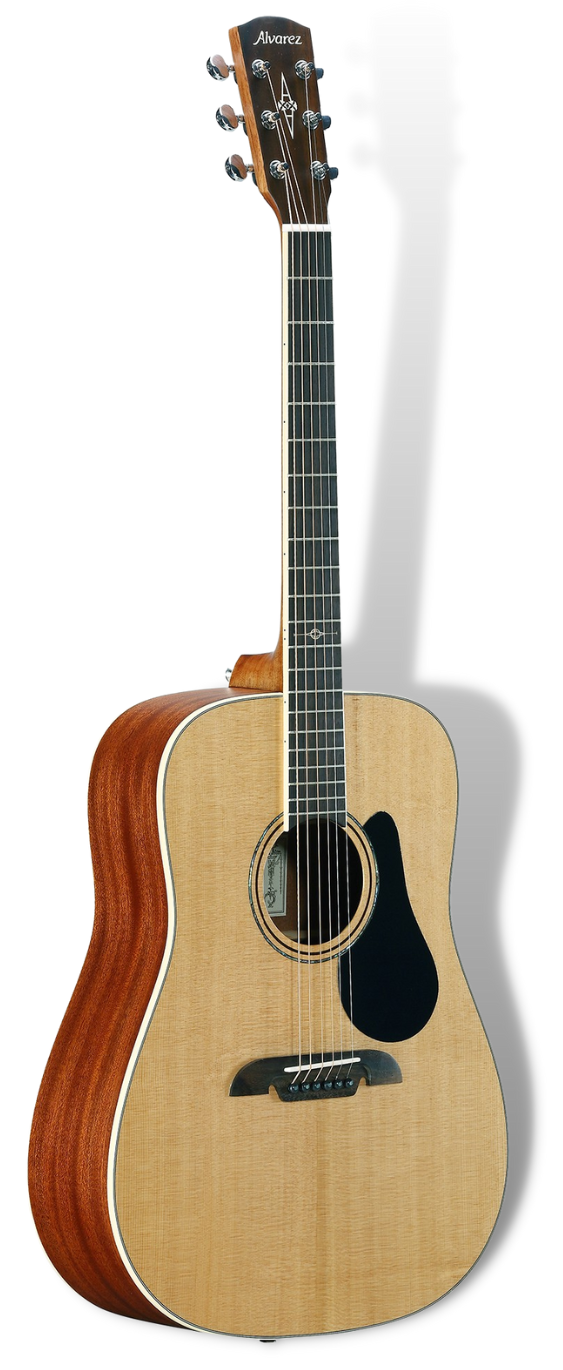
– Tuning Machines
On this Alvarez AD60, the tuning machines are simple but effective, they’re die cast, made of chrome, and have a closed gear design.
- Material: Chrome
- Design: Closed gear
The tuning machines (or “tuners”) are one of the most important parts of the hardware on any guitar.
They’re responsible for keeping the strings tight so they can vibrate properly and generate the right pitch.
Poor-quality tuning machines can cause your guitar to quickly fall out of tune and be tough to stay in tune.
They can also make changing strings more difficult, as well as making the guitar more hard to play in general.
Must Remember:
Good tuning machines are made of strong and durable materials and have a precise and smooth action.
You should look for materials that are less susceptible to rust, such as nickel-plated steel or stainless steel.
These materials are also less likely to tarnish, extending the life of your instrument.
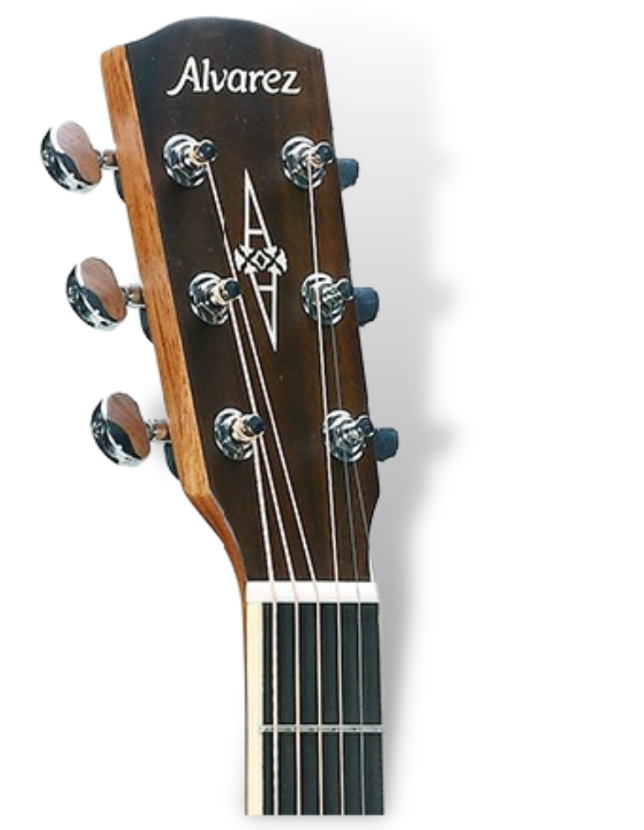
– Pickguard
The Alvarez AD60 has a black pickguard with a black design.
- Color: Black
- Design: Black
The pickguard is a little piece of plastic or metal that is positioned near the strings on the body of the guitar.
Its purpose is to protect the finish of the guitar from being scratched by the pick as you play.
Most pickguards are composed of plastic or metal, and in some cases, carbon fiber, and come in many different styles.
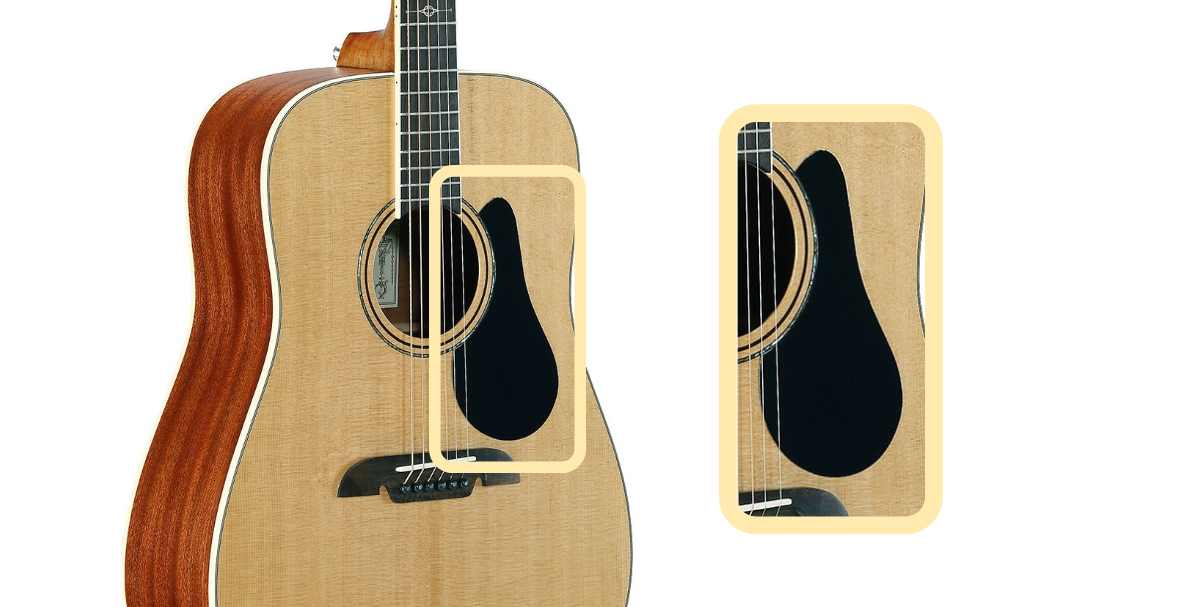
A decent pickguard should be built of a robust material that can sustain regular use when it comes to protection.
It should also be placed in such a way that it is likely to protect the guitar’s body from scratches produced by the player’s pick.
In terms of appearance, a pickguard should also blend in with the guitar’s general design and complement the overall aesthetic of the instrument.
It should neither be too small nor too low-quality, as this would make it look out of place.
– Strap Buttons
#REF!
- Material: Chrome
- Position: Bottom and back of heel
- Design: Classic
Strap buttons is what we call the little metal buttons installed on the guitar’s body that are used to connect a strap to the instrument.
One on either side of the body, most guitars will generally feature two strap buttons.
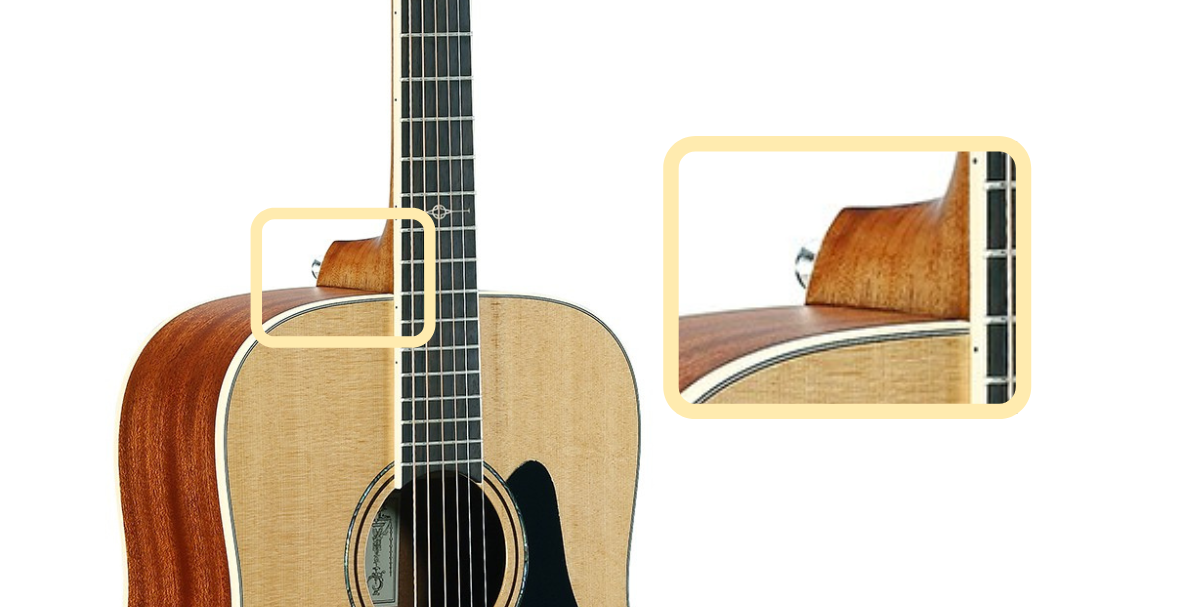
Metal strap buttons should be durable and sturdy so that they do not come loose over time.
Even though the quality of the strap buttons isn’t a deal-breaker for the majority of folks, it’s still something to consider.
Body
The neck, bridge, and strings are all joined to the guitar’s body, which is the most important section of the instrument.
A hole (the “soundhole”) through which sound can resonate from within the instrument can also be found here.
The majority of guitars have a wooden body, while others have carbon fiber, metal, or plastic bodies (less usual).
– Wood
If you’re seeking for a specific tone, the type of wood chosen for the body can alter the sound of the guitar.
#REF!
– Finish
The final layer of protection for the wood of the guitar body is the body finish.
When it comes to this guitar in specific, it has a gloss finish.
This is what gives the guitar its brilliance and shine, but also protects the wood from scratches, dents, and other wear and tear.
You’ll encounter a variety of finishes, including the following:
- Polyurethane
- Nitrocellulose Lacquer
- Polyester
Nitrocellulose Lacquer is considered to be the best type of finish, but it’s also the most expensive.
It’s a durable finish that can be buffed to a high shine, and it’s also relatively easy to repair if it’s damaged.
Polyurethane is a cheaper alternative that’s almost as good, and Polyester is the cheapest option but it doesn’t provide as much protection.
Among these categories, there are subcategories as well, such as:
- Gloss finishes: High shine and they’re very reflective.
- Matte finishes: Have a lower shine and they’re not very reflective.
- Satin finishes: Somewhere in-between gloss and matte, they have a moderate shine and they’re somewhat reflective.
– Colors Available
The color of a guitar’s body is typically not a significant factor in the overall tone.
However, it can be a factor in the look and feel of the instrument.
Some people prefer a guitar that’s a certain color because it matches their style, or because it’s easier to see in low light conditions.
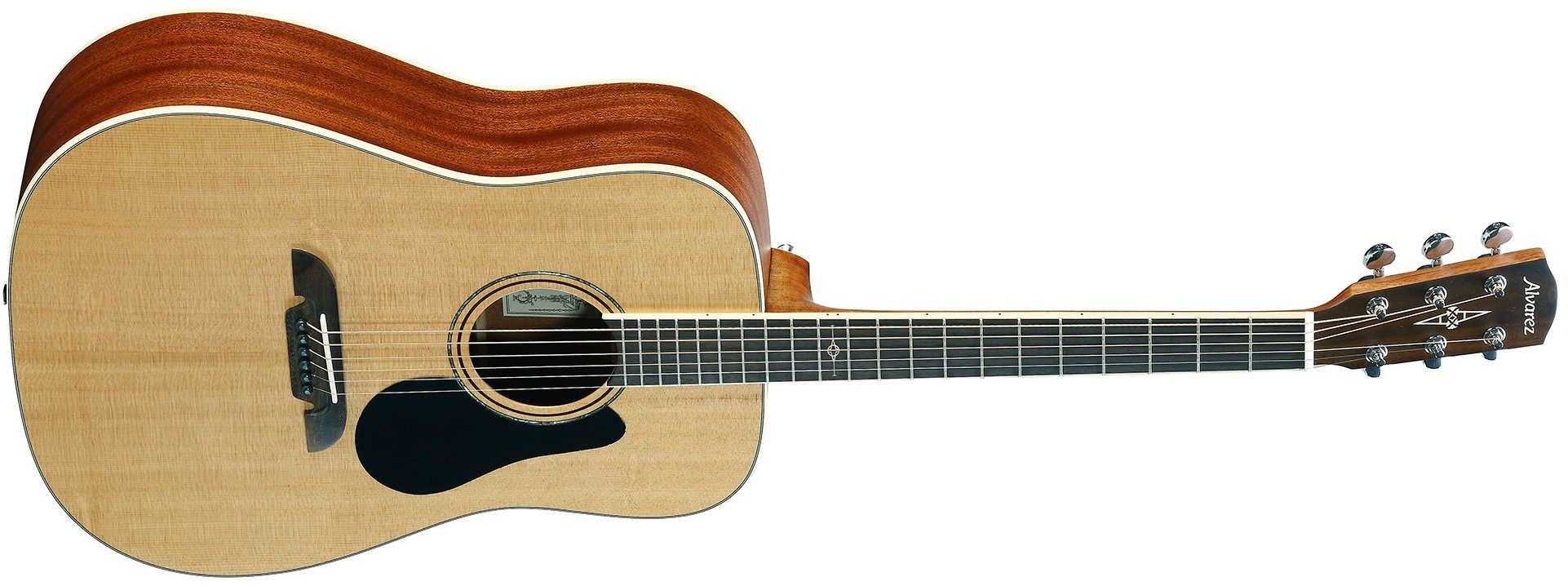
Some of the most popular colors for guitar bodies are:
- Natural: This is the color of wood that hasn’t been stained or painted.
- Black: Black is a popular color for metal-style guitars.
- Sunburst: Sunburst is a combination of light and dark colors, usually red, yellow, and brown.
– Bridge, Saddle, and Pins
The Alvarez AD60 has a standard pin bridge with black-colored polyphenylene sulfide (pps) plastic pins and a saddle made of real bone.
Each of these elements has a significant impact on how the guitar sounds and feels.
For example, the bridge is responsible for transferring string vibrations to the guitar’s body.
The saddle, which is often composed of plastic or bone, is where the strings rest.
And the pins are what hold the strings in place.

There are many different types of bridges, each with its own advantages and disadvantages.
There are three primary types of bridges used on acoustic guitars:
- Pin bridges (standard)
- Pinless bridges
- Classical bridge
Pin bridges are the most prominent type of bridge and the simplest to rebuild and replace.
However, they can be a bit more difficult to intonate, which means getting the strings in the correct position.
Pinless bridges are less common, although they are easy to intonate as well.
They also have the advantage of not requiring any pins, which can be a pain to keep track of.
Lastly, classical guitar bridges are only used on classical guitars.
They are similar in design to most other bridges, but the key distinction is that they have no pins and instead consist of a saddle and a wooden block with a hole for each string.
Said hole is used to tie the string down, which gives the guitar a much cleaner look.
Now, the type of saddle you choose is also important; plastic saddles are the cheapest and easiest to find, but they don’t last as long as bone saddles.
Bone saddles are more expensive, but they’re also more durable.
As for the bridge pins, there are three main types:
- Plastic bridge pins
- Steel bridge pins
- Brass bridge pins
Plastic bridge pins are the cheapest and easiest to find, but they’re also the least durable.
Steel bridge pins are more expensive, but they’re also more durable.
Brass bridge pins are the most expensive, but they’re also the most durable.
Neck
#REF!
The guitar’s neck is the long, thin piece that runs from the body to the headstock.
Since different woods have distinct qualities that influence how the vibrations created by the strings behave, the type of wood chosen for the neck can affect the guitar’s playability and sound.
The most popular style of neck is the bolt-on neck, which is screwed or fastened onto the body of the guitar.
Another popular type is the set-neck, which is glued to the body.
The fretboard, frets, nut, and truss rod are all crucial components of a guitar neck.
Fretboard
The fretboard is the surface on the neck of the guitar where your fingers push down on the strings.
It is often made of wood, although it can also be made of carbon fiber, plastic, or metal.
#REF!

Even though this has always been a big debate, it is generally agreed that the type of wood that’s used for the fretboard can slightly affect the sound of the guitar.
For instance, maple is a popular material for electric guitars because it tends to produce a very sharp tone.
Rosewood is another popular choice, and it’s often used on acoustic guitars because it gives the instrument a warm and full sound.
Ebony is another popular choice, and it’s frequently used on guitars with a very clean, clear tone.
There are several types of fretboards available, each with its own set of pros and cons.
The sort of fretboard you pick is ultimately up to you and what you’re looking for in a guitar; the tone will not change dramatically, but the feel will.

Videos
For those of you who want to get a more in-depth look at this guitar, we’ve included some videos below.
The first video is a demo showing off how it sounds and looks.
While the second video is a review that goes over some of its features and specs.
Demo
Review
Specifications
A guitar’s specifications can tell you a lot about the instrument, and they can be helpful when you’re trying to decide between different models.
Below, we’ve included the specifications for the Alvarez AD60:
– General
| Brand | Alvarez |
| Model | AD60 |
| Type | Acoustic |
| Size | Full Size |
| Colors | Natural |
| Number of Strings | 6 |
| Hardware Plating | Chrome |
| Tuning Machines | Die Cast |
| Electro-acoustic | No |
| Built-in Tuner | Not applicable |
– Body
| Body Style | Dreadnought |
| Cutaway | No |
| Solid Top | Yes |
| Top Material | Solid A+ Sitka Spruce |
| Back Material | African Mahogany |
| Sides Material | African Mahogany |
| Finish Type | Gloss |
| Pickguard | Yes |
| Pickguard Design | Black |
| Strap Buttons | Yes |
| Strap Buttons Position | Bottom and back of heel |
| Strap Buttons Design | Classic |
– Neck
| Neck Material | Mahogany |
| Neck Shape | Low-profile C |
| Scale Length | 25.5″ |
| Truss Rod | Adjustable |
– Fretboard
| Fretboard Material | Indian Laurel/Rosewood |
| Fingerboard Inlay | Pearloid dots |
| Number of Frets | 21 |
– Bridge, nut, saddle, pins
| Bridge Design | Standard pin bridge |
| Pin Color | Black |
| Pin Material | Polyphenylene Sulfide (PPS) Plastic |
| Bridge Material | Bi-Level Indian Laurel/Rosewood |
| Saddle Material | Real bone |
| Nut Material | Real bone |
| Nut Width | 1.75″ |
Please note that some brands might change the type of materials that they use on their guitars.
This can be because of new regulations and laws that come and go throughout the years.
If you see a mistake in any of these specifications, please let us know and we’ll correct it.
You can reach out to us via our email: [email protected]
I also encourage you to check out our other guitar reviews if you’re looking for something specific that you might have not found here with this guitar.
There are a lot of great guitars out there, and it can be tough to choose the right one sometimes.
We have reviews on electric guitars, acoustic guitars, bass guitars, effects pedals, and more.
No matter what your budget is, or what type of guitar you’re looking for, we should be able to help you find the perfect one for you.

Born and raised in Florida! I’ve been playing guitars for the past 5 years. Love to learn, and I’m always striving to achieve greater heights in music. Currently have a Fender Stratocaster as my main guitar.

